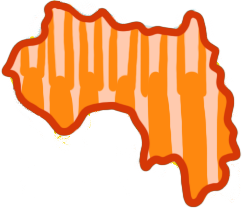Text
In this chapter, we're going to look at equatives, which allow you to say things like this proverb:
Ko bɛɛ ye waati di
'All things are a question of time'
(lit. 'All affairs are time')
Specifically, I'm gonna cover:
- How equatives are different from presentatives with
le/tɛ - Affirmative equative constructions
- Negative equative constructions
- How equatives can mix with presentatives
- How the focalization marker
lemay or may not be incorporated into equatives
Using Equatives
Earlier, I covered how to use presentative constructions to say things like:
Bon ne.
'It's a house.'
Or:
Den tɛ.
'It's not a child'
These examples like all presentative constructions are used to "present" or "identify" something that is either in one's immediate context (e.g., a town that you and a friend are looking at) or is already under discussion (e.g., a person that you ran into last night). For this reason, we can generally translate them with "It is/isn't [X]."
The equative, on the other hand, is used for situations in which you need to state that some thing (e.g., a person, place, idea, etc.) is equivalent to another thing.
For instance, we can already say something like Karanden ne ('It's a student') or So tɛ ('It's not a town'), but what happens if we wanted to say something like "I am a student" or "Guinea is not a town"?
In this case, we need to use equative constructions!
Affirmative
Let's look at the basic structure of an affirmative equative construction through a simple example:
N ye karanden di.
I EQU student EQU'I am a student.'
The underlying structure of an equative then is easy:
[X] ye [Y] di'[X] is [Y]'
The important thing to remember is that both [X] and and [Y] are nouns or things that stand in for nouns.
They can be proper nouns. For instance:
Awa ye moso di.
'Awa is a woman'
Or they can be common nouns:
Sɛnɛ ye baara di.
'Farming is work.'
Negative
Ok, so we can say that "[X] is [Y]", but what if we want to say "[X] is not [Y]"?
In this case, we only need to make one simple change. We change the initial ye to a tɛ.
So let's take a sentence like:
Adama ye karanden di
'Adama is a student'
When negative, this sentence would become instead:
Adama tɛ karanden di
'Adama is not a student'
Just like with affirmative sentences, you can use this with common nouns too. For instance, you could say something like:
Ji tɛ domuni di.
Water EQU.NEG food EQU'Water isn't food.''
► Presentatives and equatives can intermingle
While presentatives and equatives are distinct, they can, for English speakers, often translate to the same thing.
This is typically the case when words like "this/that" (nin/o) or "he/she/it" (à) are involved.
For instance, if you were introducing your friend John to someone, you could say something like:
Amerikika le.
"He's an American."
(lit. "It's an American.")
Or:
À ye amerikika di.
"He's an American."
(lit. 'He is an American.')
Because of this, presentatives and equatives can often intermingle in a single exchange.
Imagine a situation, for instance, where you are sitting with some friends and you are trying to learn the names of different types of chairs since, to you, they look different; some like stools, some like armchairs, etc.
In this context, things might play out like this:
You ask (using an equative):
Nin ye mun di?
'What is this?' (lit. 'This is what?')
And your friend responds (with a presentative):
Sigilan ne.
'It's a chair.'
Then you point and ask about another chair:
O don?
'And what about that?'
And here your friend responds (with an equative):
O fana ye sigilan di.
'That also is a chair.'
Alright, so in this example, your friend has not helped figure out the different names that one could use for different kinds of sitting devices.
But they have shown you the way that presentatives (e.g,., with le/tɛ) and equatives (e.g., with ye/tɛ ... di) intermingle in speech.
What's important to see is that one could have just as easily swapped things around and retained the same meaning:
– Mun ne?
– Nin ye sigilan di.
– O don?
– Sigilan fana le.
So, presentatives and equatives are clearly used for distinct purposes:
- Use the presentative
[X] le/tɛto identify or present nouns in sentences like "It is/isn't [X]". - Use the equative
[X] ye/tɛ [Y] dito state that one noun is equal or equivalent to another noun in sentences like "[X] is/isn't [Y]".
But know that in practice (and based off of regional preference and context for one construction over the other), they can intermingle when using words like nin/o ('this/that') and à/ale ('he/she/it') are involved.
Equatives with the focalization marker le
You may also hear equative constructions that incorporate the focalization marker le.
(NOTE: The focalization marker le is distinct from the presentative copula le even if they share the same spelling.)
Recall from when you learned how to introduce yourself that le is a particle that adds emphasis to the word or words which it follows. For instance:
N tɔɔ Adama
'My name is Adama'
VS
N tɔɔ le Adama
'My name is Adama'
(with emphasis on "my name")
Strictly speaking, le (which becomes ne if it follows a nasalized vowel) is generally not required since all it does is add emphasis to a sentence.
That said, many sentences sound more natural to native speakers when they incorporate le somewhere within them.
This is particularly the case when it comes to equatives.
Oftentimes, the focalization marker is added to one of the two nouns.
Adding le to the second noun
The focalization marker le may appear after the second noun of an equative construction.
This is done quite naturally when Maninka-speakers talk. In fact, it's arguably more frequent than equatives sentence with no focalization marker.
For instance:
N ye karanden le di
'I am a student'
Or:
Adama ye karamɔɔ le di
'Adama is a teacher'
Adding le to the first noun
The focalization marker le can also be added the first noun an an equative construction.
For example:
Baara le ye o di
'Work is that'
(as in, "That is (hard) work")
In these cases, it often sounds as if it replaces ye. For instance:
Baara le ye o di → [Baara le (ye) o di]
'Work is that'
Indeed, this is arguably a case of an actual linguistic change in process where le truly is beginning to replace ye in some equative sentences.
Why? Because in some Maninka texts, you may actually see le completely in place of ye:
Baara le o di
'Work is that'
(Note the lack of
yein the Maninka sentence)
Which form should you use? I think it's best practice to learn the equative as based around ye...di plus an optional focalization marker: NOUN-1 ye (le) NOUN-2 di.
Then, once you are at ease with things, you can pronounce the sentences like you hear those around you doing—with or without ye.
(NOTE: One phrase that occurs a lot where ye is dropped is Ale le o di [Lit. "It is that"; as in, "That's it"; cf. C'est ça en français]. You might want to watch out for that one from the beginning!)
Summary
Ayiwa! We covered the following about equatives:
-
They are formed like this:
NOUN +
ye/tɛ+ NOUN +di -
They allow you to say that a noun is or is not equal or equivalent to another noun (e.g., "Coke is a drink"; "Bamako is not a country")
-
They are distinct from presentatives, which you use to say the equivalent of what can often be translate as "It's [X]" or "That is [X]".
-
They can intermingle with presentatives in interaction.
-
Equatives are often used with a focalization marker added to the first or the second noun
NOUN (
le) +ye/tɛ+ NOUN (le) +di -
When
leis added to the first noun, it may end up replacing the originalyeof an equative construction:NOUN
le (ye)NOUNdi
Vocab
Coming soon n'Ala sɔnna!
- X ye (le) [Y] di
- X is [Y]
- X tɛ [Y] di
- X is not [Y]
- siilan
- chair
- mun
- what
- ɲiman/ɲuman/juman
- which
- yɔrɔ-juman-ka
- resident of which place [used in questions]
- I ye yɔrɔ-juman-ka (le) di?
- "Where are you from?" [lit. 'You are a which-placer?']
- I la baara ye mun di?
- What is your work?
- fatɔ
- crazy person
- baasi
- problem
- mɔbili/mobili
- car; vehicle
- tuma
- time; moment
- waati
- time; moment; period
- mɔɔbakɔdɔ
- elder person
- -tii
- owner/manager of
- jawola
- merchant; trader
- maninka (< manden-ka)
- Maninka; Malinké (< 'person from Manden')
- bamanan
- Bambara (person)
- jula
- Jula (person); merchant/trader
- fula [fla]
- Fulani (person)
- Laginɛka
- Guinean (person)
- Maliden
- Malian (person) [lit. 'Mali-child']
- Kodiwarika
- Ivoirian (person)
- Amerikika
- American (person)
- butiki
- store; shop (< Fr. boutique)
- makasan
- store; shop
- karanbon
- school
- lemunun
- lemon
- lemununji
- lemonade
- ko
- affair; matter
- fen
- thing
- so
- town; village; city [or "house" in Bambara]
- bon
- house; room
- lu
- courtyard
- duu
- ground; earth [or "town" in Bambara]
- nɛɛso
- bike
- maninkakan
- Maninka (language)
- bamanankan
- Bambara (language)
- julakan
- Jula (language)
- tubabukan
- French (language)
- angilɛkan/anglais-kan
- English
- bɛɛ
- all
- gbɛdɛ
- another
- do
- some
- jɛdɛ/yɛdɛ
- even; self; own [Fr. "même"]
- si
- none; no
Vocab list will be here someday!
Flashcards will be here someday!
Exercises
Exercises will be here someday!




